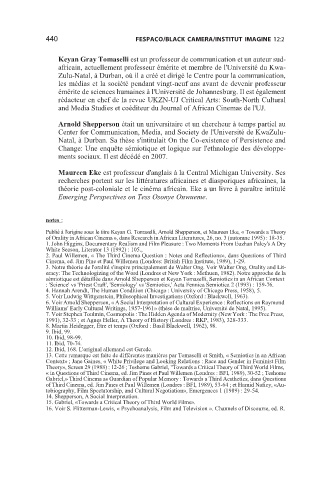Page 449 - Livre2_NC
P. 449
440 FESPACO/BLACK CAMERA/INSTITUT IMAGINE 12:2
Keyan Gray Tomaselli est un professeur de communication et un auteur sud-
africain, actuellement professeur émérite et membre de l'Université du Kwa-
Zulu-Natal, à Durban, où il a créé et dirigé le Centre pour la communication,
les médias et la société pendant vingt-neuf ans avant de devenir professeur
émérite de sciences humaines à l'Université de Johannesburg. Il est également
rédacteur en chef de la revue UKZN-UJ Critical Arts: South-North Cultural
and Media Studies et coéditeur du Journal of African Cinemas de l'UJ.
Arnold Shepperson était un universitaire et un chercheur à temps partiel au
Center for Communication, Media, and Society de l'Université de KwaZulu-
Natal, à Durban. Sa thèse s'intitulait On the Co-existence of Persistence and
Change: Une enquête sémiotique et logique sur l'ethnologie des développe-
ments sociaux. Il est décédé en 2007.
Maureen Eke est professeur d'anglais à la Central Michigan University. Ses
recherches portent sur les littératures africaines et diasporiques africaines, la
théorie post-coloniale et le cinéma africain. Eke a un livre à paraître intitulé
Emerging Perspectives on Tess Osonye Onwueme.
notes :
Publié à l'origine sous le titre Keyan G. Tomaselli, Arnold Shepperson, et Maureen Eke, « Towards a Theory
of Orality in African Cinema », dans Research in African Literatures, 26, no. 3 (automne 1995) : 18-35.
1. John Higgins, Documentary Realism and Film Pleasure : Two Moments From Euzhan Palcy's A Dry
White Season, Literator 13 (1992) : 105.,
2. Paul Willemen, « The Third Cinema Question : Notes and Reflections», dans Questions of Third
Cinema, ed. Jim Pine et Paul Willemen (Londres: British Film Institute, 1989), 1-29.
3. Notre théorie de l'oralité s'inspire principalement de Walter Ong. Voir Walter Ong, Orality and Lit-
eracy: The Technologizing of the Word (Londres et New York : Methuen, 1982). Notre approche de la
sémiotique est détaillée dans Arnold Shepperson et Keyan Tomaselli, Semiotics in an African Context
: 'Science' vs 'Priest Craft', 'Semiology' vs 'Semiotics,' Acta Fennica Semiotica 2 (1993) : 159-76.
4. Hannah Arendt, The Human Condition (Chicago : University of Chicago Press, 1958), 5.
5. Voir Ludwig Wittgenstein, Philosophical Investigations (Oxford : Blackwell, 1963).
6. Voir Arnold Shepperson, « A Social Interpretation of Cultural Experience : Reflections on Raymond
Williams' Early Cultural Writings, 1957-1961» (thèse de maîtrise, Université de Natal, 1995).
7. Voir Stephen Toulmin, Cosmopolis : The Hidden Agenda of Modernity (New York : The Free Press,
1991), 32-33 ; et Agnes Heller, A Theory of History (Londres : RKP, 1983), 328-333.
8. Martin Heidegger, Être et temps (Oxford : Basil Blackwell, 1962), 98.
9. Ibid, 99.
10. Ibid, 98-99.
11. Ibid, 70-74.
12. Ibid, 168. L'original allemand est Gerede.
13. Cette remarque est faite de différentes manières par Tomaselli et Smith, « Semiotics in an African
Context» ; Jane Gaines, « White Privilege and Looking Relations : Race and Gender in Feminist Film
Theory», Screen 29 (1988) : 12-26 ; Teshome Gabriel, "Towards a Critical Theory of Third World Films,
« in Questions of Third Cinema, ed. Jim Pines et Paul Willemen (Londres : BFI, 1989), 30-52 ; Teshome
Gabriel,» Third Cinema as Guardian of Popular Memory : Towards a Third Aesthetics, dans Questions
of Third Cinema, ed. Jim Pines et Paul Willemen (Londres : BFI, 1989), 53-64 ; et Hamid Naficy, «Au-
tobiography, Film Spectatorship, and Cultural Negotiation», Emergences 1 (1989) : 29-54.
14. Shepperson, A Social Interpretation.
15. Gabriel, «Towards a Critical Theory of Third World Films».
16. Voir S. Flitterman-Lewis, « Psychoanalysis, Film and Television ». Channels of Discourse, ed. R.

